
Discover the Pola Museum of Art – A Hidden Gem in the Forest
Nestled quietly in the lush forests of Hakone, the Pola Museum of Art opened in 2002 and is located within the Fuji-Hakone-Izu National Park. This peaceful museum is a perfect place to enjoy both world-class art and the beauty of nature throughout the seasons. It truly offers a relaxing, healing experience.
The museum grounds also feature a nature trail, so after viewing the exhibitions, you can take a peaceful walk through the forest. On sunny days, the sound of birds and the sunlight filtering through the trees make the visit even more special—you can carry the feeling of the art with you into the woods.

The Building Itself Is a Work of Art
Because the museum is located inside a national park, there are strict building regulations, including limits on building height. As a result, the exhibition spaces are built underground.
However, you wouldn’t notice it at all. Thanks to the large open atrium and natural light pouring in from above, the interior feels bright and spacious. Unlike some museums that can feel dark or overly quiet, the Pola Museum is welcoming and full of natural light.
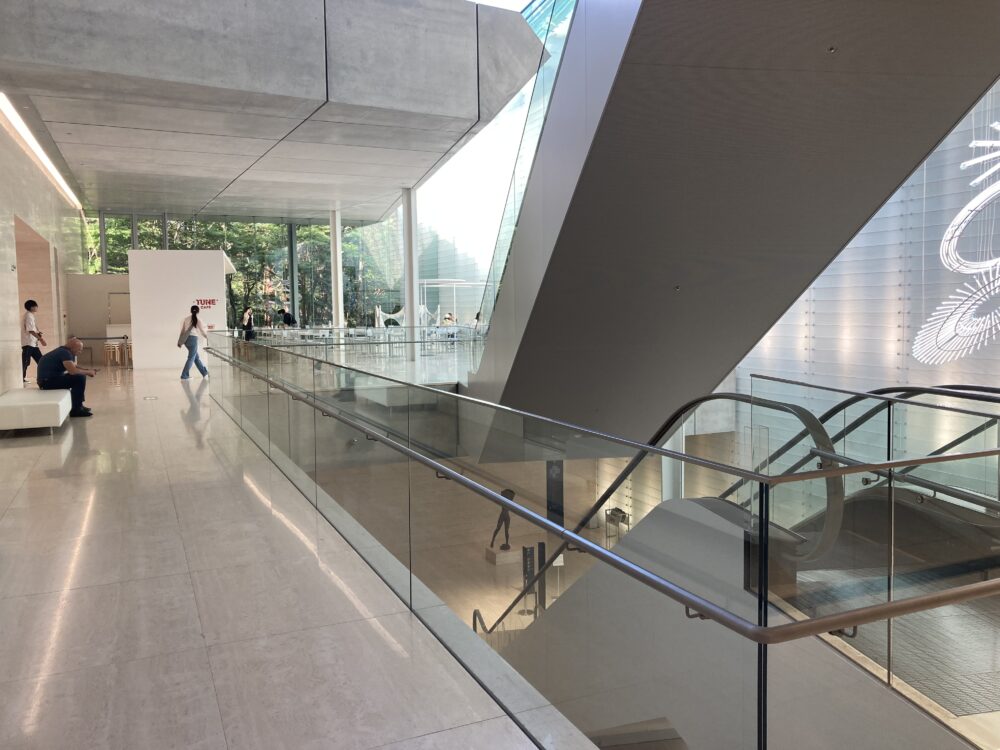
Masterpieces by Monet, Van Gogh, and Fujita—An Impressive Global Collection
One of the most remarkable things about the Pola Museum is its outstanding collection. The museum’s core comes from the private collection of Tsuneji Suzuki, the second-generation head of the Pola Group, who spent decades acquiring these works.
You’ll find masterpieces by Impressionist and Post-Impressionist giants like Monet, Renoir, Van Gogh, and Cézanne, as well as many works from the École de Paris, including Modigliani, Chagall, and Tsuguharu Foujita. The collection also features classic works by artists like Ingres and Delacroix, offering a wide range of styles and eras to enjoy.
The museum owns about 10,000 artworks in total. Since the permanent exhibition rotates regularly, you’re likely to see something new each time you visit. You can check the latest exhibition schedule on the museum’s official website.
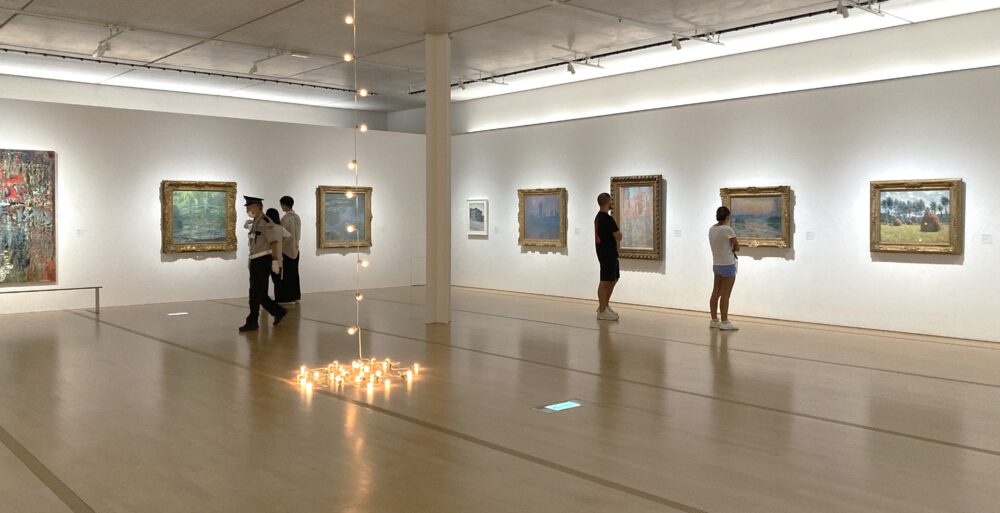
Masterpieces by Monet and Van Gogh – Highlights from the Pola Museum Collection
At the Pola Museum of Art, you’ll find world-famous paintings displayed in an unexpectedly casual way. You might find yourself thinking, “Wait, I can see this in Japan?” — and yes, you really can.
Even if you’re not an art expert, many of the pieces have a magical power to draw you in once you’re standing in front of them. Below are a few highlights from the museum’s incredible collection.
Note: The artworks on display may change due to exhibition rotation. Be sure to check the official website before your visit!
Claude Monet, “Water Lily Pond” (1899)
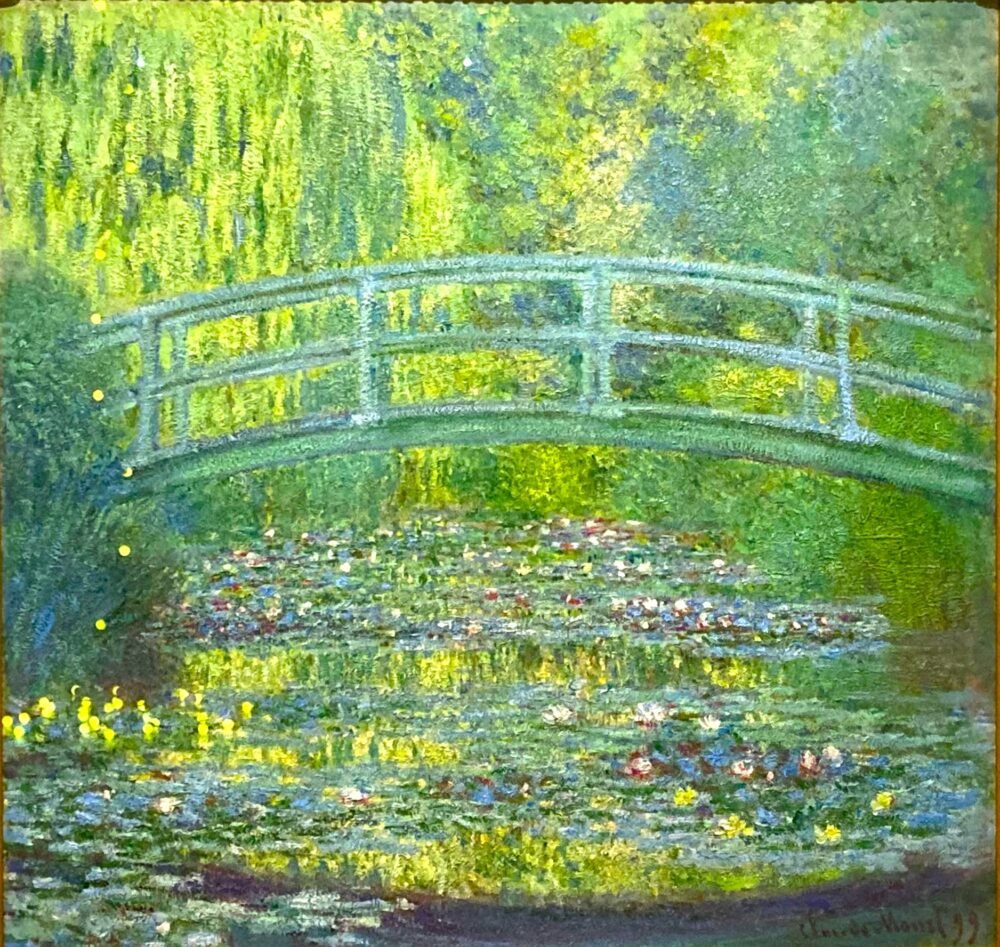
About This Work (Tap or Click to View)
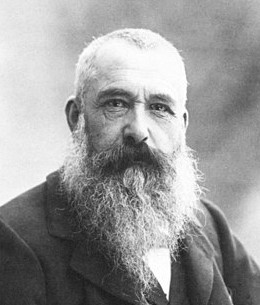
Monet’s Famous “Water Garden” in Giverny
One of the most beloved works at the museum is Claude Monet’s Water Lily Pond (1899).
Monet, a leading figure of Impressionism, spent his later years in Giverny, France, where he dedicated himself to capturing the beauty of his surroundings.
In 1893, he purchased land next to his home and created a “water garden” from scratch — complete with a Japanese-style arched bridge over a pond filled with water lilies. It became his lifelong source of inspiration and one of the most iconic subjects in his art.
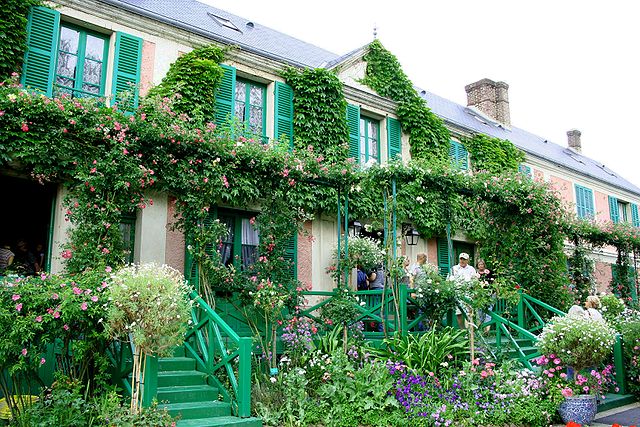
img: by Spedona
A Brilliant Work from the “Japanese Bridge” Series
This painting is part of Monet’s first Japanese Bridge series, created around 1899–1900 — a period when he began painting water lilies in earnest.
Sunlight filters in from the back of the scene, gently reflecting off the pond’s surface and nearby trees. The subtle blue-gray foreground contrasts beautifully with the brighter background. The result is a glowing, vivid harmony of colors.
This piece clearly reflects how Monet saw and felt nature — quiet, yet emotionally powerful. His brushwork and color choices bring his serene garden vividly to life.
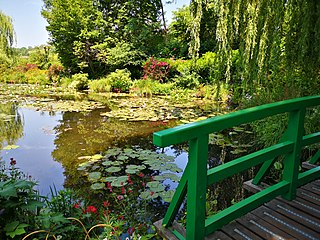
img: by World3000
Claude Monet, “Rouen Cathedral” (1892)
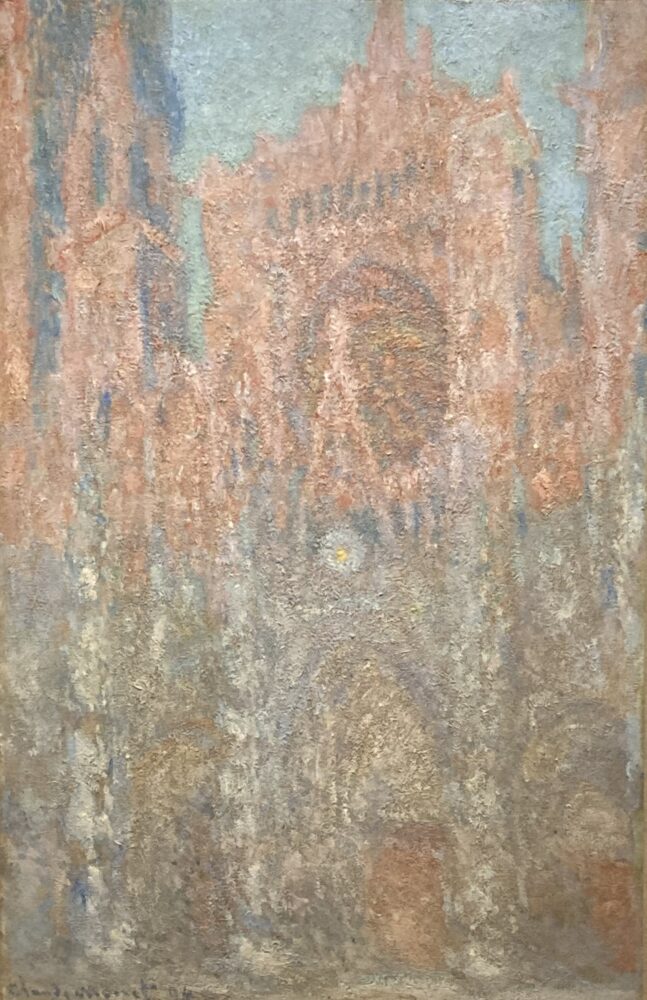
About This Work (Tap or Click to View)
A Surprising Series from the Master of Landscapes
Another highlight in the Pola Museum’s collection is Monet’s Rouen Cathedral (1892). While Monet is famous for painting nature, this work features the grand Gothic architecture of Rouen Cathedral in Normandy, France.
Between 1892 and 1893, Monet painted more than 30 views of the cathedral from his temporary studio across the street. What fascinated him wasn’t the building itself, but the changing light — how shadows and colors shifted with the time of day and the weather.
Soft Gradients of Pink and Blue
The version housed at the Pola Museum is believed to depict the cathedral around 6 p.m., just before sunset. The top of the cathedral glows faintly pink, while the bottom half falls into a soft, bluish shadow from the neighboring buildings.
The gentle contrast in color makes the painting feel calm and peaceful.
Look closely and you’ll notice that the building’s outlines are a bit blurry, almost dreamlike. Monet wasn’t focused on perfectly capturing the structure — he wanted to paint the atmosphere and the quality of the light. Though his brushwork appears loose, it’s carefully calculated.
Instead of using bright, bold colors, Monet layered soft grays and muted tones to express the delicate and complex hues of natural light — that’s the true magic of this piece.
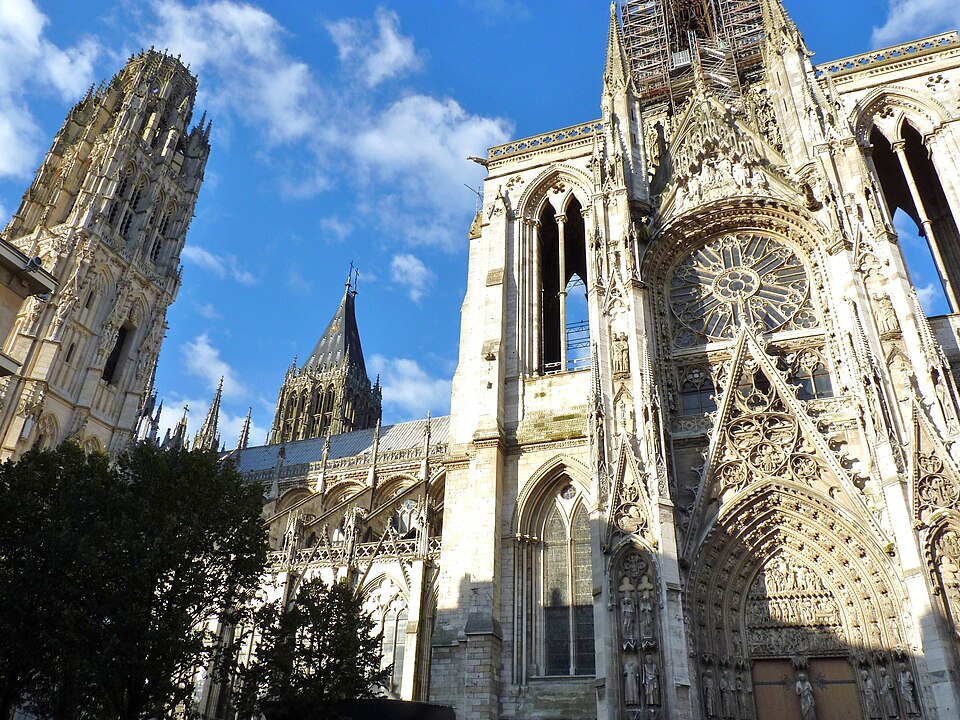
img: by Béa0350
Auguste Renoir, “Girl with a Lace Hat” (1891)
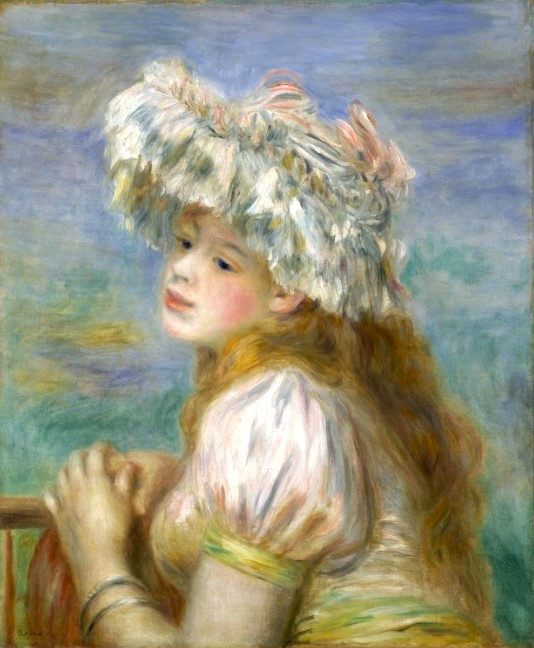
About This Work (Tap or Click to View)

A Masterpiece from Renoir’s “Pearlescent Period”
Auguste Renoir was one of the leading artists of the French Impressionist movement, best known for his warm, gentle portraits of women and children.
But Renoir didn’t always paint in the same style. Throughout his career, he adapted his technique depending on the period and his personal feelings.
This piece, Girl with a Lace Hat, was painted during what is known as his “pearlescent period.” It features soft, light tones based on white, creating a dreamy quality where colors seem to melt into light.

Soft Outlines, Strong Presence
What immediately stands out in this painting is Renoir’s signature softness. The voluminous lace hat, the silky hair, the delicate skin — they all look so real you almost feel like you could reach out and touch them.
Renoir often used loose, blurry outlines, yet his subjects still feel vivid and full of life. That ability to convey presence through gentle, blended brushwork is a hallmark of his style.
A Natural and Graceful Moment
The girl’s pose is simple and natural. She slightly lifts her chin, gazing off into the distance. There’s nothing forced — it feels like a quiet moment captured in time.
Combined with Renoir’s tender brushstrokes, this painting has a calming presence that gently touches the viewer’s heart.
Georges Seurat, “Low Tide at Grandcamp” (1885)
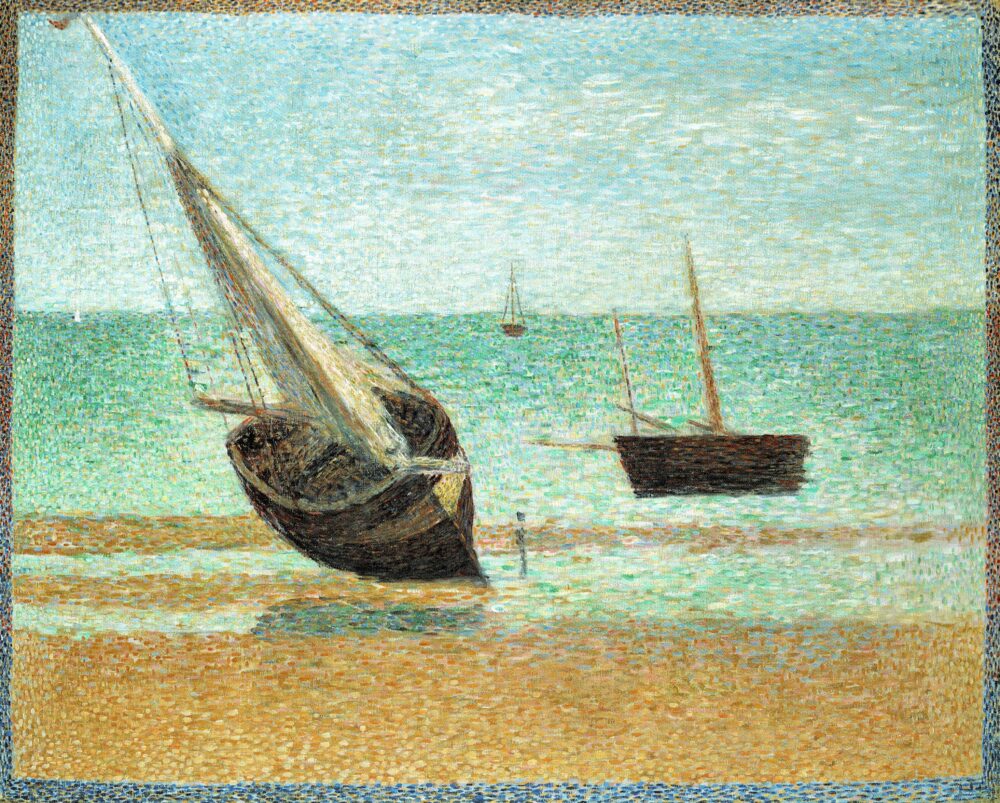
About This Work (Tap or Click to View)
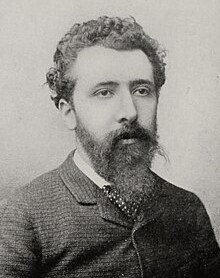
A Pointillist View of the Normandy Coast
Georges Seurat was a pioneer of Neo-Impressionism, known for developing pointillism — a technique that used small, precise dots of color based on scientific color theory.
This painting, Low Tide at Grandcamp (1885), was exhibited at the Second Salon des Indépendants alongside his most famous work, A Sunday Afternoon on the Island of La Grande Jatte.
It depicts the quiet coast of Grandcamp, a harbor town in Normandy, France. Three boats sit calmly in a low-tide scene, all rendered using Seurat’s meticulous dot technique.

img: by Archangel12
Simple Composition, Complex Balance
At first glance, this may seem like a peaceful and ordinary seascape. But the composition is carefully structured.
A horizontal line separates the sea from the sand, creating a sense of calm. One of the boats leans diagonally, adding a subtle tension that draws the eye deeper into the scene.
Two more boats in the background create a feeling of open space and rhythm. Though the layout is minimal, it has a strong visual impact.
Dots of Color, Not Blended — But Harmonized
Pointillism, Seurat’s signature method, involves placing tiny dots of color side by side rather than blending them.
In this work, the sandy beach appears orange and the sea blue — but if you look closely, you’ll notice tiny contrasting colors (complementary hues) scattered within. These combinations create a vivid, shimmering effect that feels both bright and deep.
Pay attention to the darker tones near the horizon. Instead of mixing pigments to create shadows, Seurat placed cool colors like blue and green next to each other, preserving brightness while still creating depth — a unique feature of pointillism.
Painting with Theory, Not Just Instinct

Seurat was heavily influenced by color theorists like Eugène Chevreul and Charles Blanc. He studied their writings and used scientific principles to build his own techniques.
Instead of focusing only on how to paint, Seurat asked why certain colors should be used together. His approach led to pointillism — placing colors side by side to let the viewer’s eye do the mixing.
This method combines logic and emotion, giving his works a quiet, poetic atmosphere.
Low Tide at Grandcamp isn’t flashy, but it leaves a lasting impression. When you see it in person, take time to enjoy how each tiny dot creates a sense of light, air, and harmony.
Paul Cézanne, “Landscape in Provence” (1879–1882)
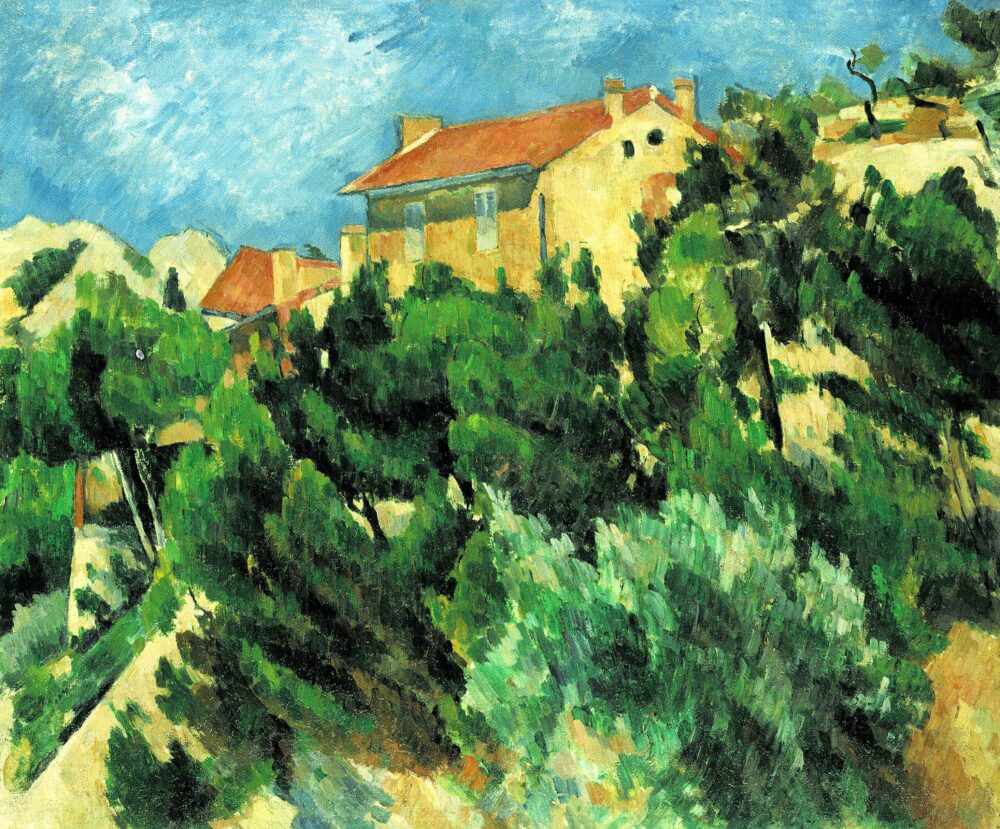
About This Work (Tap or Click to View)

How Cézanne Saw the Shape of Provence
Paul Cézanne was a key figure in the Post-Impressionist movement.
Although he started within the Impressionist circle, he wasn’t content just painting what he saw — he was always searching for a more personal, deeper way of seeing and expressing.
This piece, Landscape in Provence, captures a scene from Cézanne’s hometown in the South of France.
It’s not a famous landmark or dramatic view — just a simple slice of nature.
And yet, something powerful seems to radiate from the canvas.
The reason? It’s in how he painted it.
Cézanne’s brushstrokes are slanted and structured — known as his “constructive brushwork.”
Instead of blending colors smoothly, he built up the scene like a puzzle — stacking shapes of color to create the landscape.
The trees, the ground, even the sky — everything feels like it was assembled, not just painted.
“Nature as Cylinders, Spheres, and Cones”
Cézanne once said,
“Treat nature by the cylinder, the sphere, the cone.”
In other words, he wasn’t just painting scenery — he was analyzing it, breaking it down into basic geometric forms.
This way of thinking directly influenced the birth of Cubism, and artists like Picasso and Braque picked up where Cézanne left off.
So this painting isn’t just a view of Provence.
It’s Cézanne’s bold attempt to capture the structure of nature itself — a quiet, thoughtful piece that feels both grounded and full of meaning the longer you look.
Vincent van Gogh, “The Gleize Bridge over the Vigueirat Canal” (March 1888)
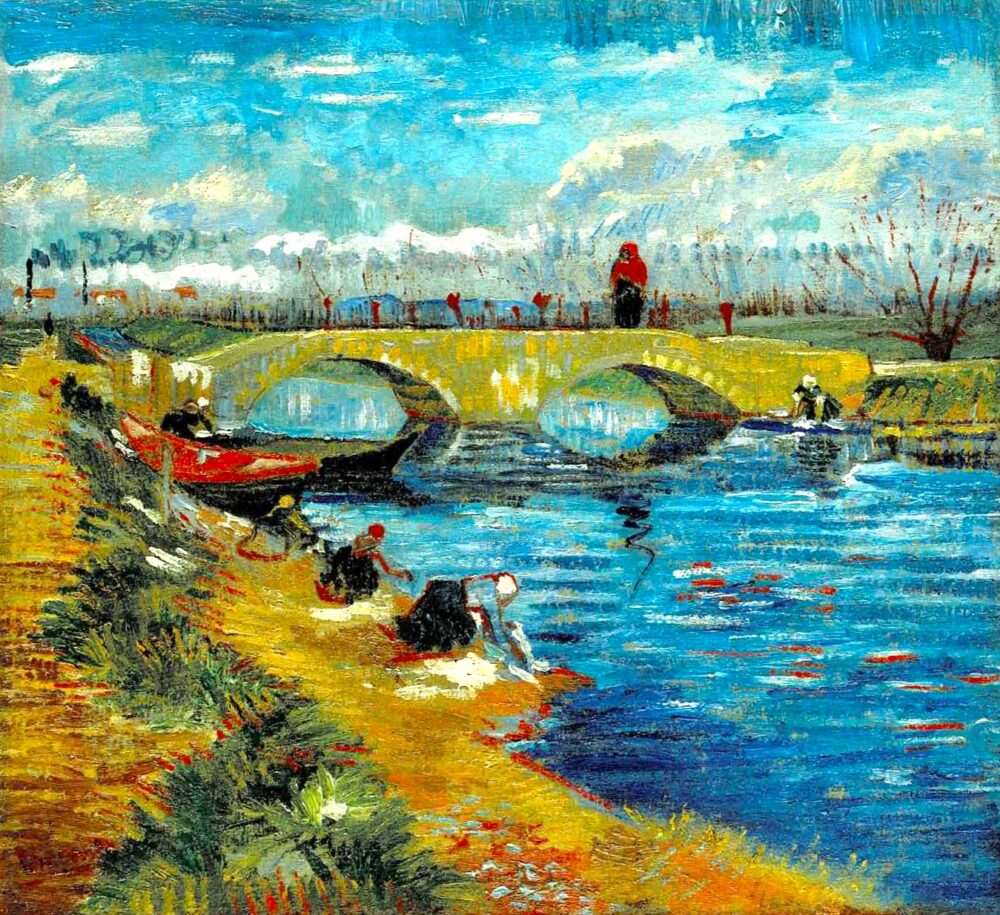
About This Work (Tap or Click to View)
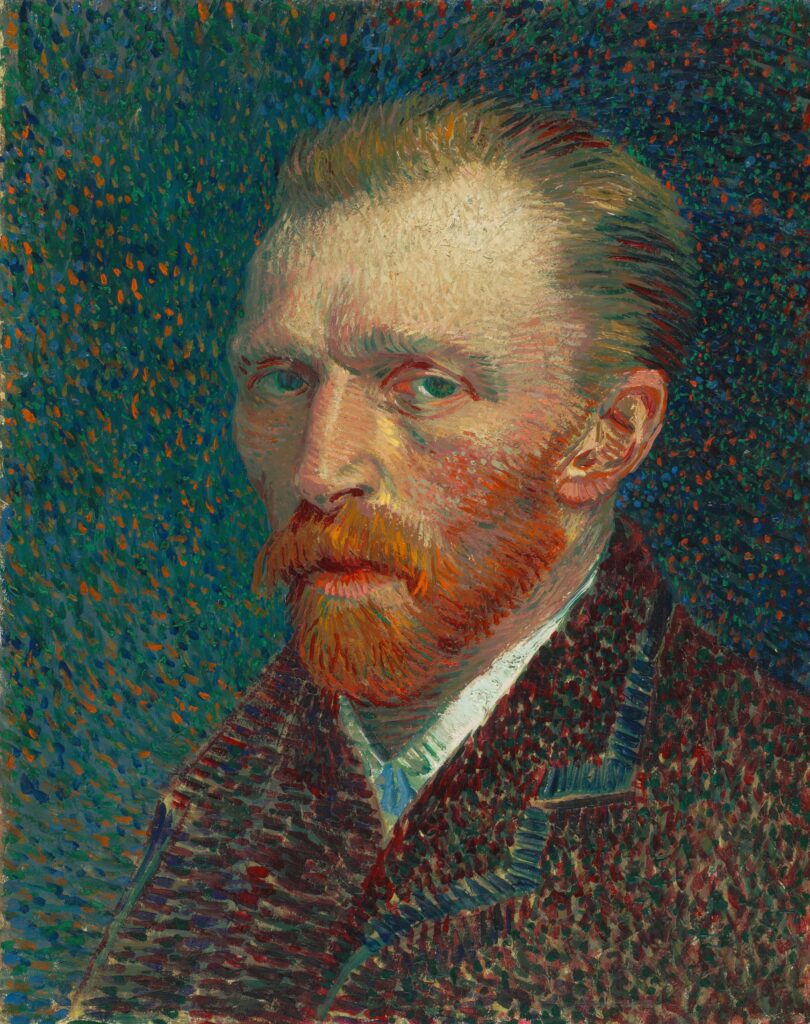
Van Gogh’s Southern Journey Begins
In 1888, Vincent van Gogh moved south to Arles, France, chasing warmer weather, brighter skies, and new inspiration.
In a letter to his brother Theo that March, he wrote:
“Today I brought back a size 15 canvas — a painting of a drawbridge with a small cart crossing it, its silhouette standing against the blue sky — with blue water below, an orange bank with green grass, and a group of washerwomen in colorful bonnets…”
This painting, The Gleize Bridge over the Vigueirat Canal, is one of the two works he mentioned (the other being the more famous Langlois Bridge).
At the time, Van Gogh was completely taken by the southern light and atmosphere — and it shows.
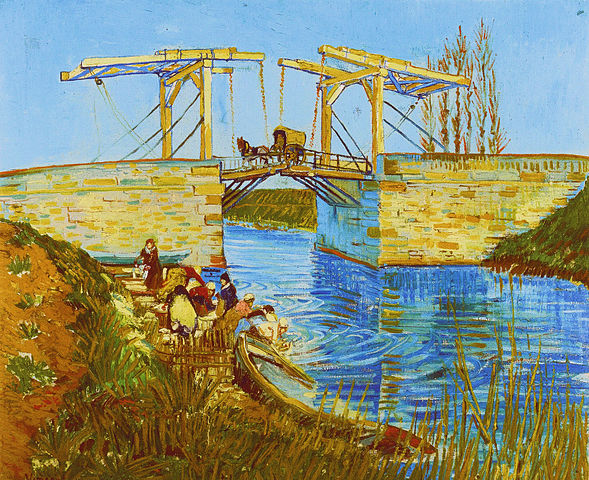
The First Spark of the Arles Period
Van Gogh came to Arles partly because he was fascinated by Japanese art.
He saw similarities between Japanese prints and the bright, bold nature of southern France — and he hoped to find a place that felt like a “European Japan.”
The Gleize Bridge is one of his early works from Arles, and you can already see his use of bold color coming alive.
The deep blues of sky and water, the vivid yellow of the banks, and scattered touches of bright red — even in the canal — show how he was experimenting with complementary color contrasts.
Before moving to Arles, Van Gogh mostly painted what he saw, in a fairly straightforward way.
But here, you can see him beginning to manipulate color for emotional impact, not just realism.
This piece marks the start of a new chapter — leading to masterpieces like Café Terrace at Night, The Night Café, and of course, Sunflowers.
It’s the first flicker of Van Gogh’s golden period, where his signature style fully blossomed.
Vilhelm Hammershøi, “Woman Reading in the Sunlight, Strandgade 30” (1889)
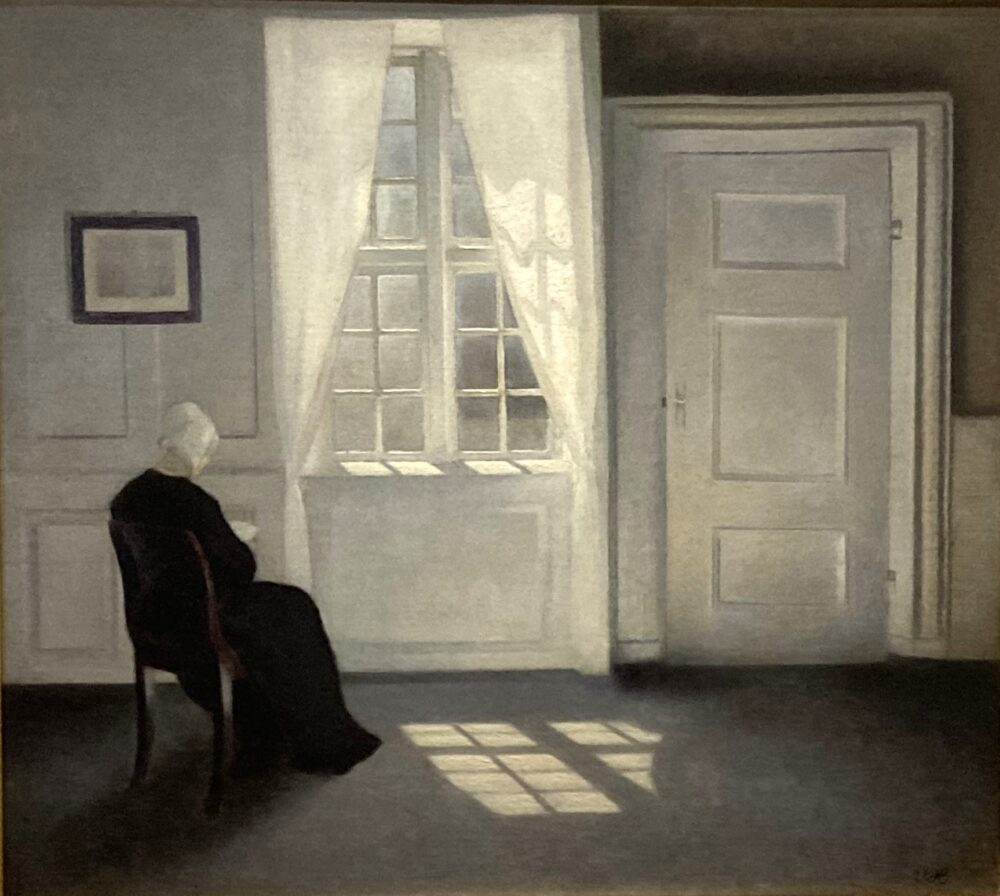
About This Work (Tap or Click to View)
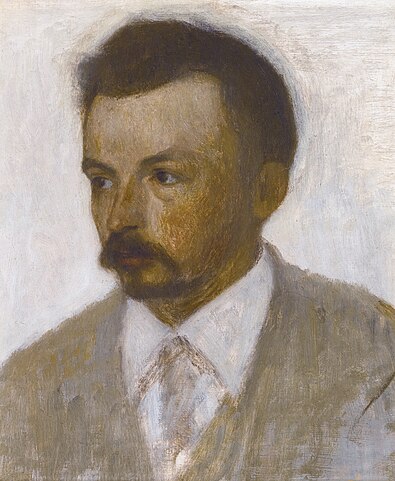
Silence with a Sense of Presence
Have you ever heard of Vilhelm Hammershøi?
He was a Danish painter active in the late 19th and early 20th centuries, known for his quiet, minimalist style. His paintings are calm and understated—but somehow, you can’t look away.
“Woman Reading in the Sunlight, Strandgade 30” (1889) is one of his most iconic works. It shows a woman quietly reading in a simple, sunlit room. The location? It’s actually a room in Hammershøi’s own apartment in Strandgade 30, Copenhagen.
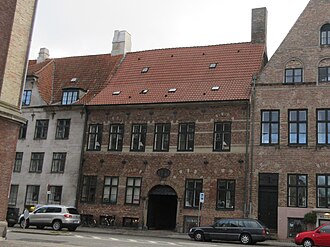
This very room on the ground floor is where the painting takes place.
img: by Ramblersen2
A Quiet Space with Subtle Tension
At first glance, not much seems to be happening:
A woman sits alone, reading, her back turned to us. We can’t see her face. She seems still—almost frozen in time.
The room is almost empty: minimal furniture, muted gray walls and floors, and soft light coming in through the window. That’s it. And yet, this peaceful space feels full of quiet tension.
Notice the slightly ajar door in the corner.
It suggests that someone might walk in—or maybe no one will. That uncertain pause in the scene creates a subtle, lingering suspense. It feels like something could happen at any moment, even though nothing does.
Hammershøi doesn’t tell a story in the usual sense.
Instead, he lets the space itself speak. This isn’t just a portrait—it’s a mood, a feeling, an atmosphere. The power of the painting lies in what’s not shown, as much as what is.
A Painting Full of Imagination
This quiet interior invites you to imagine your own story.
Why is the woman there? What is she reading? Is she waiting for someone? The painting doesn’t answer these questions—but that’s exactly what makes it so compelling.
If you visit the museum, take a moment to sit with this artwork. Let its silence speak to you.
Bonus Tip:
If you’re interested in more of Hammershøi’s work, check out the painting “Interior with Ida Playing the Piano” at the National Museum of Western Art in Tokyo.
▶ Read more in our National Museum of Western Art article
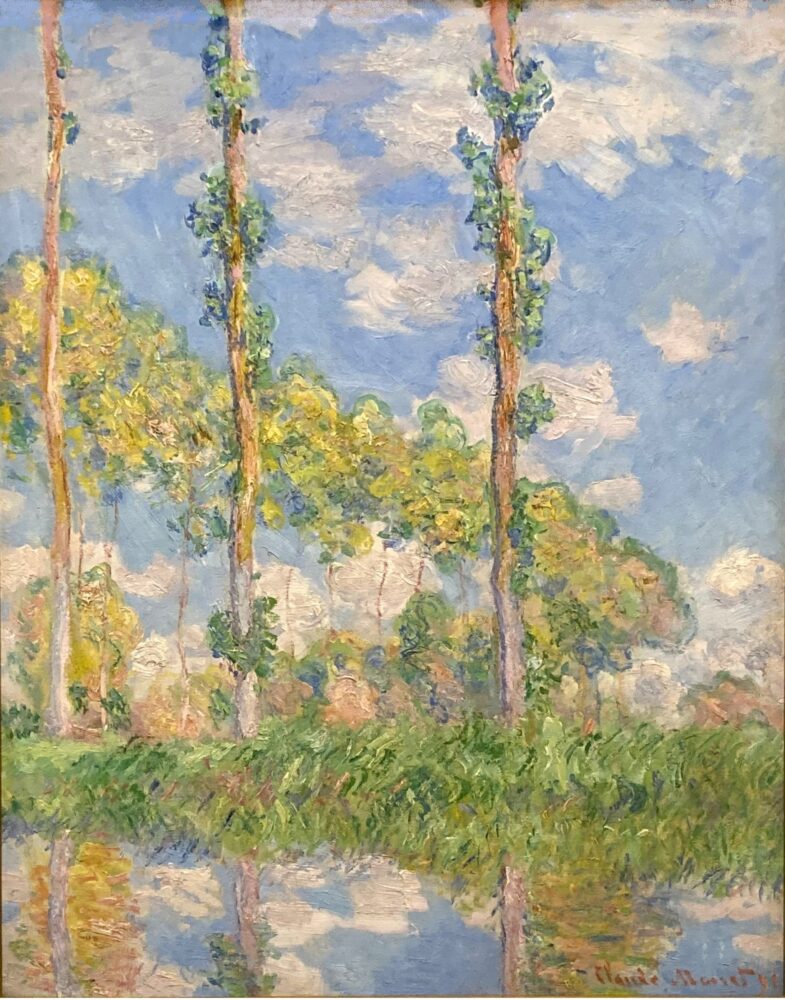
Forest Walking Trail — Let Art Linger in Nature
The beauty of the Pola Museum of Art doesn’t stop at the gallery walls.
Surrounding the museum is a 1-kilometer forest trail, offering a peaceful walk through nature that perfectly complements the experience inside.
Located at around 760 meters above sea level, the museum is surrounded by a lush forest of beech and Japanese stewartia trees.
Depending on the season, the light through the leaves and the scent of the air change. In spring and fall, you might even spot wild birds or small forest animals.
After taking in the artworks indoors, stepping into the quiet of the forest feels incredibly refreshing.
Take your time—sit on a bench, breathe deeply, or just walk with no destination. It’s a chance to clear your mind and settle your thoughts.
This walking trail offers what you might call “blank space for the soul” after the art.
It’s a gentle moment to reflect on what you’ve seen, or simply to enjoy the silence of nature.
If you visit the Pola Museum, don’t miss this “gallery in the woods.”
In Summary: A Museum Where Art and Nature Come Together
The Pola Museum of Art is more than just a place to see art.
Surrounded by the quiet forests of Hakone, it invites you to experience art in a slower, more mindful way—away from the noise of everyday life.
Inside, you’ll find masterpieces by Monet, Renoir, Van Gogh, Cézanne, and also unique artists like Seurat and Hammershøi.
Each work is displayed in bright, spacious rooms designed to feel calm and open.
But what makes the Pola Museum truly special is the experience of seeing these works in this particular setting.
With forest trails, natural light, and even a cozy café, it’s the kind of museum where you’ll want to spend an entire day.
It’s not just about viewing art—it’s about letting time slow down.
Even if you’re not an art expert, the peaceful atmosphere helps open your senses naturally.
If you’re visiting Hakone, the Pola Museum is definitely worth a stop.
You just might discover a painting that stays with you long after you leave.

Visitor Information — Pola Museum of Art, Hakone
Location:1285 Kozukayama, Sengokuhara, Hakone, Kanagawa Prefecture, Japan







Comments